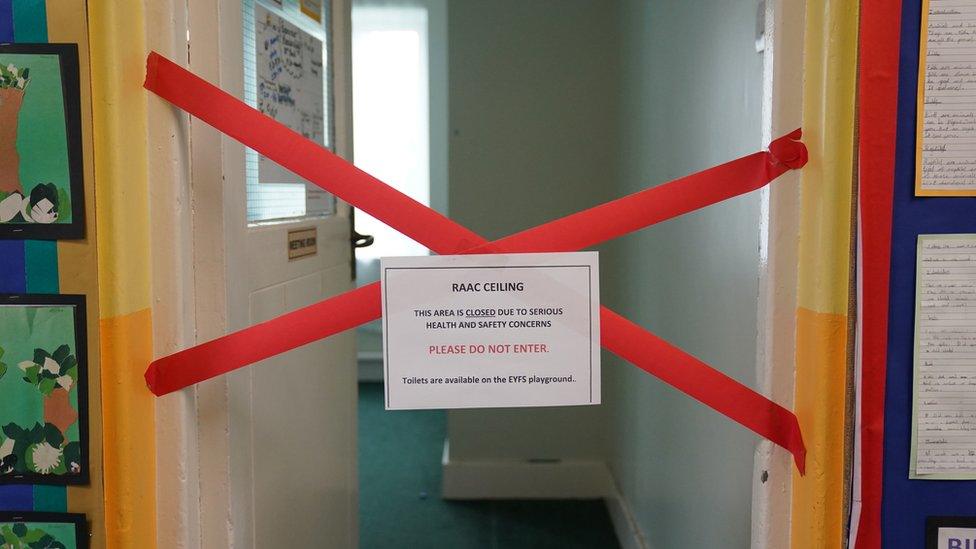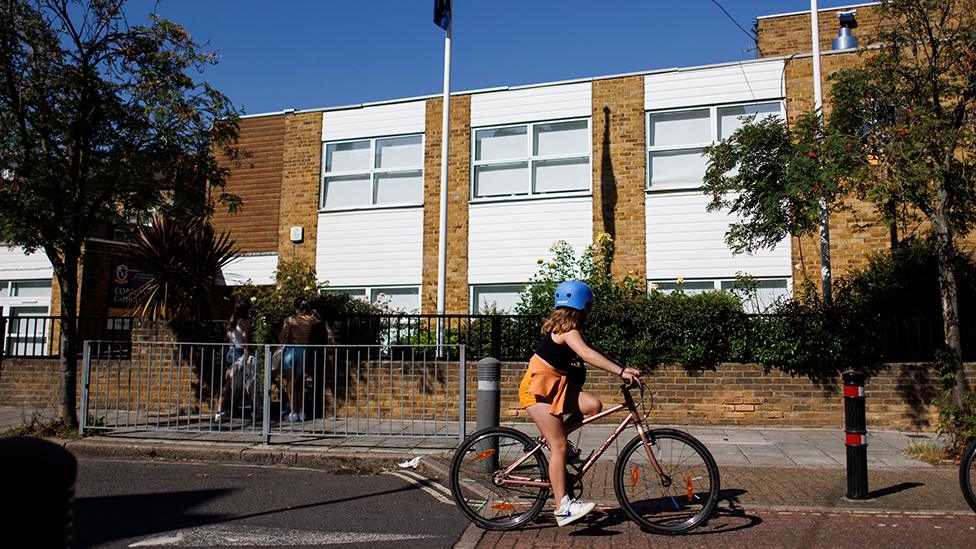Raac: More than 100 school buildings will be rebuilt or refurbished
- Published

More than 100 school buildings containing a dangerous concrete will be rebuilt or refurbished, the government has confirmed.
It says all affected schools will receive funding to permanently remove it - although, unions say the announcement includes no new money.
In England, 234 schools contain reinforced autoclaved aerated concrete (Raac).
The material was used as a cheaper alternative to standard concrete.
But after a beam collapsed, schools containing Raac were told to shut areas where no safety measures were in place, just days before the start of term last August.
All schools built in the era when the concrete was used have now responded to a questionnaire, the Department for Education (DfE) has said, and surveys have been completed on all those that suspected they might have Raac.
A small number of schools and colleges were conducting additional checks, for further assurance, in some spaces, it added.
Raac, used between the 1950s and 1990s, has a lifespan of about 30 years .
Of the 234 schools and colleges, external confirmed to contain the concrete:
119 will have one or more buildings rebuilt or refurbished through the school rebuilding programme (SRP)
110 will receive grant funding to remove it from their buildings
five have alternative arrangements in place - for example, the building will no longer be part of the school estate
All 234 (about 1% of all schools in England) have reportedly returned to face-to face learning - but many children are still being taught in marquees, portable classrooms or off site.
Unions, though, are worried about existing school-rebuilding funds being used for the affected schools.
The DfE would now have "less money in its capital spending and maintenance budgets" to afford much-needed works, National Education Union general secretary Daniel Kebede said.
Association of School and College Leaders general secretary Geoff Barton said clear timelines for this work were also needed, as well as "catch-up provision for pupils whose learning has been impacted".
'Big crisis'
Pupils in some affected schools have been unable to access design-and-technology workrooms, laboratories and other specialist spaces.
Some have had to switch courses months before their GCSEs and miss out on required science experiments - but the government says it will not change exams as a result.
There have also been reports of parents removing children from schools with dangerous concrete.
National Association of Head Teachers (NAHT) general secretary Paul Whiteman said concern remained the full extent of schools affected was unknown, as not all surveys had been completed successfully, and the government needed a plan to tackle "all school building issues", such as asbestos, "before they become the next big crisis".
'Tireless work'
About 700,000 children are being taught in unsafe or ageing buildings, according to a National Audit Office report.
Education Secretary Gillian Keegan thanked all schools, colleges and local authorities for their "tireless work" ensuring children remained in face-to-face learning.
"Nothing is more important to me than the safety of every child and member of staff in school," she said.
"We will continue to work closely with schools and colleges as we take the next step to permanently remove Raac from affected buildings."

Are you affected by the issues raised in this story? Share your experiences by emailing haveyoursay@bbc.co.uk, external.
Please include a contact number if you are willing to speak to a BBC journalist. You can also get in touch in the following ways:
WhatsApp: +44 7756 165803
Tweet: @BBC_HaveYourSay, external
Please read our terms & conditions and privacy policy
If you are reading this page and can't see the form you will need to visit the mobile version of the BBC website to submit your question or comment or you can email us at HaveYourSay@bbc.co.uk, external. Please include your name, age and location with any submission.
- Published13 February 2024

- Published18 January 2024